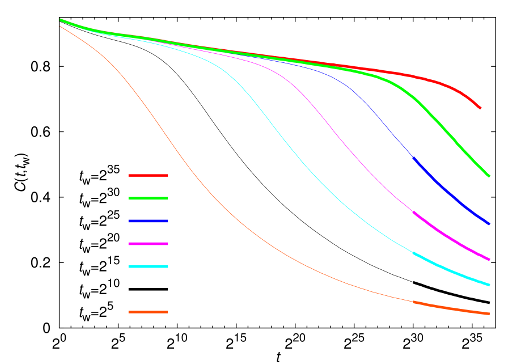spin glasses
Spin glasses are magnetic alloys that have one salient feature: their properties are never stable as time goes by. When you cool a spin glass below its critical temperature, its properties keep changing for years (although the change is slower as the spin-glass ages). The phenomenon of Aging is not peculiar of spin glasses: many other systems of great industrial relevance (polymers, structural glasses, etc.) suffer it. Aging is important: if the resistance of the materials the wings of your airplane are made of is changing with time, you may be worried. Spin glasses are regarded by scientists as a particularly simple model system to study Aging. However, in spite of their simplicity (as compared with polymers, for instance), spin glasses are still quite a headache for physicists!
We study two kinds of spin glasses: Heisenberg (where the spins are three-dimensional vectors) and Ising (uniaxial spins). We perform both critical-point and low-temperature studies, in and out of equilibrium, using large-scale computing clusters and custom-built computers. In particular, the Janus computer has allowed us to investigate the dynamics for eleven orders of magnitude, from picoseconds to a tenth of a second.
 The figure represents the two-time correlation function of an Ising spin glass after
a rapid quench through the critical temperature. The system is left to equilibrate
for a time tw and then probed at a later time t + tw. Although for short t a quasi-equilibrium
regime is apparent, at later times the correlation does depend on tw. In the glassy
phase, tw, the age of the glass, is the relevant time scale. In the plot, thicker
lines correspond to the time scales newly explored thanks to the Janus
computer.
The figure represents the two-time correlation function of an Ising spin glass after
a rapid quench through the critical temperature. The system is left to equilibrate
for a time tw and then probed at a later time t + tw. Although for short t a quasi-equilibrium
regime is apparent, at later times the correlation does depend on tw. In the glassy
phase, tw, the age of the glass, is the relevant time scale. In the plot, thicker
lines correspond to the time scales newly explored thanks to the Janus
computer.